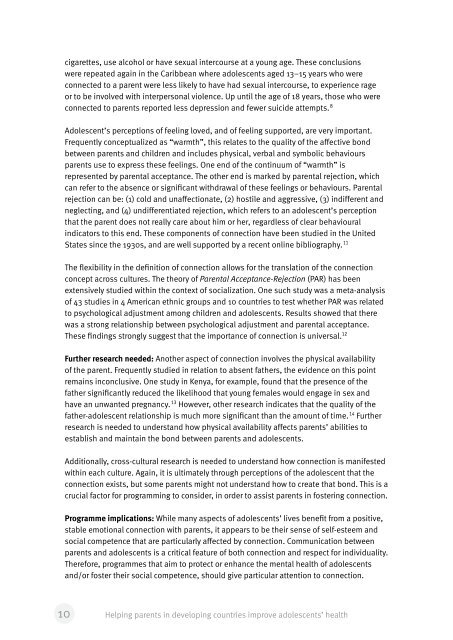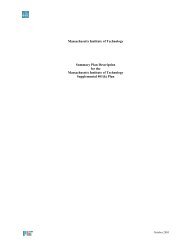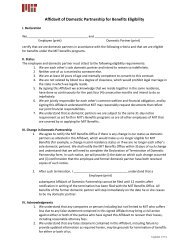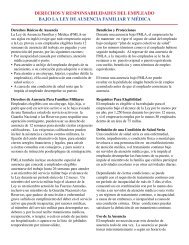Helping parents in developing countries improve adolescents' health
Helping parents in developing countries improve adolescents' health
Helping parents in developing countries improve adolescents' health
You also want an ePaper? Increase the reach of your titles
YUMPU automatically turns print PDFs into web optimized ePapers that Google loves.
cigarettes, use alcohol or have sexual <strong>in</strong>tercourse at a young age. These conclusions<br />
were repeated aga<strong>in</strong> <strong>in</strong> the Caribbean where adolescents aged 13–15 years who were<br />
connected to a parent were less likely to have had sexual <strong>in</strong>tercourse, to experience rage<br />
or to be <strong>in</strong>volved with <strong>in</strong>terpersonal violence. Up until the age of 18 years, those who were<br />
connected to <strong>parents</strong> reported less depression and fewer suicide attempts. 8<br />
Adolescent’s perceptions of feel<strong>in</strong>g loved, and of feel<strong>in</strong>g supported, are very important.<br />
Frequently conceptualized as “warmth”, this relates to the quality of the affective bond<br />
between <strong>parents</strong> and children and <strong>in</strong>cludes physical, verbal and symbolic behaviours<br />
<strong>parents</strong> use to express these feel<strong>in</strong>gs. One end of the cont<strong>in</strong>uum of “warmth” is<br />
represented by parental acceptance. The other end is marked by parental rejection, which<br />
can refer to the absence or significant withdrawal of these feel<strong>in</strong>gs or behaviours. Parental<br />
rejection can be: (1) cold and unaffectionate, (2) hostile and aggressive, (3) <strong>in</strong>different and<br />
neglect<strong>in</strong>g, and (4) undifferentiated rejection, which refers to an adolescent’s perception<br />
that the parent does not really care about him or her, regardless of clear behavioural<br />
<strong>in</strong>dicators to this end. These components of connection have been studied <strong>in</strong> the United<br />
States s<strong>in</strong>ce the 1930s, and are well supported by a recent onl<strong>in</strong>e bibliography. 11<br />
The flexibility <strong>in</strong> the def<strong>in</strong>ition of connection allows for the translation of the connection<br />
concept across cultures. The theory of Parental Acceptance-Rejection (PAR) has been<br />
extensively studied with<strong>in</strong> the context of socialization. One such study was a meta-analysis<br />
of 43 studies <strong>in</strong> 4 American ethnic groups and 10 <strong>countries</strong> to test whether PAR was related<br />
to psychological adjustment among children and adolescents. Results showed that there<br />
was a strong relationship between psychological adjustment and parental acceptance.<br />
These f<strong>in</strong>d<strong>in</strong>gs strongly suggest that the importance of connection is universal. 12<br />
Further research needed: Another aspect of connection <strong>in</strong>volves the physical availability<br />
of the parent. Frequently studied <strong>in</strong> relation to absent fathers, the evidence on this po<strong>in</strong>t<br />
rema<strong>in</strong>s <strong>in</strong>conclusive. One study <strong>in</strong> Kenya, for example, found that the presence of the<br />
father significantly reduced the likelihood that young females would engage <strong>in</strong> sex and<br />
have an unwanted pregnancy. 13 However, other research <strong>in</strong>dicates that the quality of the<br />
father-adolescent relationship is much more significant than the amount of time. 14 Further<br />
research is needed to understand how physical availability affects <strong>parents</strong>’ abilities to<br />
establish and ma<strong>in</strong>ta<strong>in</strong> the bond between <strong>parents</strong> and adolescents.<br />
Additionally, cross-cultural research is needed to understand how connection is manifested<br />
with<strong>in</strong> each culture. Aga<strong>in</strong>, it is ultimately through perceptions of the adolescent that the<br />
connection exists, but some <strong>parents</strong> might not understand how to create that bond. This is a<br />
crucial factor for programm<strong>in</strong>g to consider, <strong>in</strong> order to assist <strong>parents</strong> <strong>in</strong> foster<strong>in</strong>g connection.<br />
Programme implications: While many aspects of adolescents’ lives benefit from a positive,<br />
stable emotional connection with <strong>parents</strong>, it appears to be their sense of self-esteem and<br />
social competence that are particularly affected by connection. Communication between<br />
<strong>parents</strong> and adolescents is a critical feature of both connection and respect for <strong>in</strong>dividuality.<br />
Therefore, programmes that aim to protect or enhance the mental <strong>health</strong> of adolescents<br />
and/or foster their social competence, should give particular attention to connection.<br />
10 <strong>Help<strong>in</strong>g</strong> <strong>parents</strong> <strong>in</strong> develop<strong>in</strong>g <strong>countries</strong> <strong>improve</strong> adolescents’ <strong>health</strong>

















